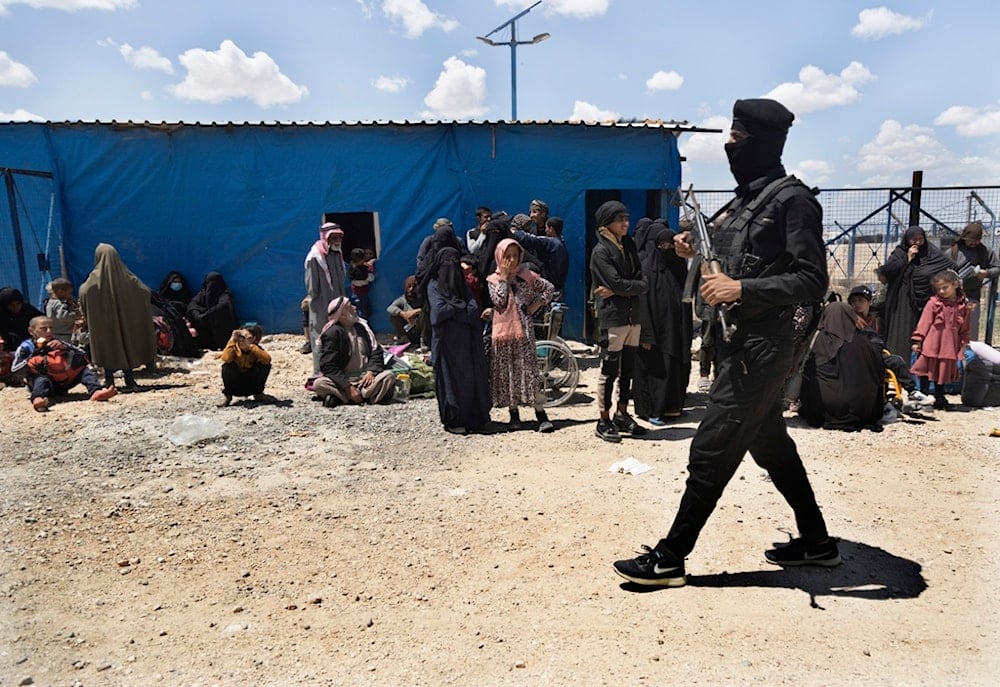US should reconsider presence in Syria as tribal anger rises
Arab tribes have long harbored grievances against the SDF, which is largely dominated by Kurdish forces.
-

A US-backed Syrian Democratic Forces (SDF) militant, passes in front of family members of suspected Islamic State group militants who are waiting to be transferred from al-Hol camp, in Hasakeh province, Syria, Wednesday, May 8, 2024 (AP)
An opinion piece published in The National Interest on Friday argued that the US should reconsider its military presence in northeast Syria due to escalating risks and diminishing strategic benefits.
According to writer Alexander Langlois, unresolved tensions between the US-backed Syrian Democratic Forces (SDF) and government-aligned Arab tribes have led to repeated flare-ups, trapping locals and around 900 US troops in a prolonged conflict.
The author claims that efforts on the part of Iran and the Syrian government are covertly mobilized to "destabilize the region", with the specific aim of forcing a US withdrawal by exploiting local ethnic tensions and economic grievances.
Langlois alleges that the Axis of Resistance led by Iran, which includes Hezbollah, has used the Syria-Iraq border for transferring weapons, making the US presence a direct obstacle to their goals.
The reality, however, is that Arab tribes have long harbored grievances against the SDF, which is largely dominated by Kurdish forces.
This is mainly owed to political marginalization, economic neglect, and heavy-handed security measures, including forced conscription and restrictions on free speech.
Therefore, Langlois overlooks the fact that, whether or not the Syrian government or Iran may have exploited tribal tensions, these tensions were already present before their involvement.
Read more: Syrian Tribes initiate wide-scale op to reclaim US-occupied territory
The article argues that the risks to US troops, who are increasingly targeted by movements of Resistance, now outweigh the strategic benefits of their presence in Syria.
He suggests that while the US deployment is meant to deter alleged Iranian weapons transfer operations, the ongoing conflict and hostile environment are exposing US forces to unnecessary danger.
The US should consider a responsible withdrawal in his view, thus allowing regional actors to take over security responsibilities.
Langlois concludes that such a shift could still achieve US objectives in the region without putting American troops at further risk, while acknowledging that broader issues in Syria will likely remain unresolved for the foreseeable future.
Violence in Deir Ezzor led to several casualties
The latest outbreak of violence between the SDF and local Arab tribes erupted in Deir Ezzor in late August and early September 2024.
The clashes intensified around August 6, marking one of the worst escalations since a similar conflict erupted nearly a year prior.
The conflict centers on prominent tribes like the al-Aqeedat, whose leader, Sheikh Ibrahim al-Hifl, is a key figure in the anti-SDF movement.
His supporters have accused the SDF of committing human rights violations and undermining Arab leadership in the region.
Although some tribes have refrained from engaging in combat, others have taken up arms, claiming that they are being forced into a subservient role under the Kurdish-dominated SDF, leading to violent clashes across towns like al-Dhiban and Abu Hamam
Read more: US bolsters bases in northeastern Syria with Apache helicopters

 3 Min Read
3 Min Read








